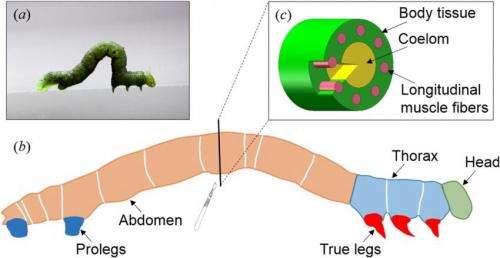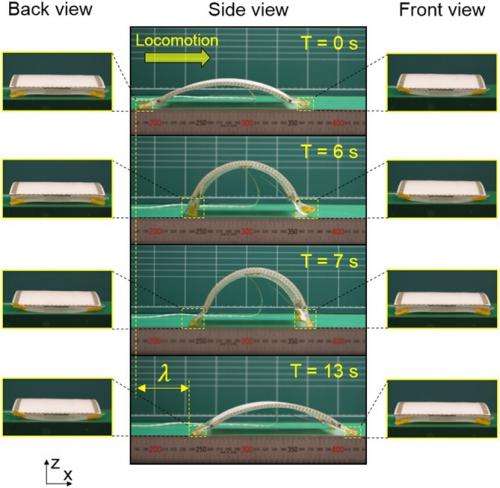November 10, 2014 feature
Robot that moves like an inchworm could go places other robots can't

The peculiar way that an inchworm inches along a surface may not be fast compared to using legs, wings, or wheels, but it does have advantages when it comes to maneuvering in small spaces. This is one of the reasons why researchers have designed and built a soft, worm-like robot that moves with a typical inchworm gait, pulling its body up and extending it forward to navigate its environment. The robots could one day be used in rescue and reconnaissance missions in places that are inaccessible to humans or larger robots.
The researchers, Wei Wang, et al., at Seoul National University in South Korea, have published their paper on the inchworm-inspired robot in a recent issue of Bioinspiration & Biomimetics.
In nature, the inchworm is the larvae phase of the geometer moth and measures about an inch or two long. The small green worm has two or three legs near its front, and two or three foot-like structures called "prolegs" at its rear end. Although they don't have bones, inchworms have complex muscle systems that allow them to perform a variety of body movements, including standing up vertically on their back prolegs.
To mimic the inchworm, the researchers used the soft, highly flexible silicone material PDMS for the robot's body. The researchers built an inchworm mold using a 3D printer, and then poured PDMS solution into the mold. Then they glued small pieces of polyimide film to make feet at the front and rear ends. To play the role of muscle fibers, the researchers used eight longitudinal shape memory alloy (SMA) wires that extend throughout the inchworm robot's body.
By actuating the SMA wires with electric currents, the researchers could cause the inchworm robot's body to move with a natural inchworm gait. Actuating the SMA wires symmetrically causes the robot's body to contract symmetrically, resulting in linear motion. Asymmetrical actuation results in asymmetric deformation and a turning locomotion using one foot as an anchor. In the inchworm gait, the feet must continually change from being used as anchors to sliding in order to generate the push-pull motion. The researchers used alternating low-friction and high-friction foot segments to replicate these foot changes.

Tests showed that the inchworm robot achieves a stride length of 54 mm (about 2 inches), which is about one-third of its body length, at a speed of about 3.6 mm/s. Turning is slower and more complicated, requiring 21 strides to complete a 90-degree turn. Still, this performance marks an improvement, both in stride length and turning angle, compared to previous similar robots.
In addition, the inchworm robot is simple, lightweight, and quiet. These features make the robot useful not only for rescue and reconnaissance missions, but also as a potential material for smart structures and wearable devices. In the future, the researchers plan to focus on improving the robot's mobility using an independent control system.
"We want to apply the locomotion and control algorithm of the inchworm-inspired robot to other motor-based robots in order to make quiet, flexible, yet load-carrying machines," coauthor Sung-Hoon Ahn, Professor at Seoul National University, told Phys.org. "We also want to extend our smart soft composite technology to other types of mechanisms, such as soft artificial limbs, soft electronic appliances, transforming automobiles, etc."
More information: Wei Wang, et al. "Locomotion of inchworm-inspired robot made of smart soft composite (SSC)." Bioinspiration & Biomimetics. DOI: 10.1088/1748-3182/9/4/046006
© 2014 TechXplore











.jpg)






